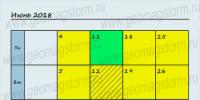Hanging a straight line on the ground. Geometry
a A Kosinova Julia, Artamonova Maria
At school, we study geometric constructions in some detail with the help of a compass and ruler and solve many problems. And how to solve the same problems on the ground? After all, it is impossible to imagine such a huge compass that could outline the circumference of a school stadium or a ruler for marking the paths of a park.
Knowledge of geometry and the ability to apply this knowledge in practice is useful in any profession. Traditionally, construction on the ground is carried out for surveying the plan of the land and for laying foundations. However, such knowledge is quite often needed in other areas of activity.
You might think that working on the ground is no different from working with compasses and a ruler on ordinary paper. But it's not. On the ground, the distances between the points are quite large and there are no rulers and compasses that could help us. And in general, it is difficult to draw any lines on the ground. Thus, constructions on the ground, based on geometric laws, have their own specifics.
Specificity Firstly, all straight lines are not drawn on the ground, but are laid, that is, a rather dense network of points is marked on them, for example, with pegs. Usually, laying straight lines on the ground is called hanging straight lines.
Secondly, it is forbidden to draw any arcs during constructions. Therefore, we actually do not have a compass. All that remains of the compass is the ability to plot specific distances on given (laid) straight lines, which must be specified not numerically, but with the help of two points, already marked with pegs, somewhere on the ground. The distances themselves will be measured by steps, feet, fingers, or any object suitable for this purpose.
In order for the pole to stand straight, a plumb line is used (some kind of weight suspended on a thread). A number of milestones driven into the ground and denotes a segment of a straight line on the ground. In the chosen direction, two milestones are placed at a distance from each other, there are other milestones between them, so that looking through one, the others are covered by each other.
Milestone - a vertical straight pole, which becomes to indicate a point on the ground, has a length of about 2 m; pointed at one end so that it can be stuck into the ground
The technique of "carrying out" long segments of straight lines on the ground is called hanging. It is widely used in practice, for example, when cutting forest clearings, when laying a highway or railway, high-voltage transmission lines, etc.
Hanging a straight line on the ground. observer
Thank you for your attention!
The video lesson "Hanging a straight line on the ground" is a visual aid that makes it easier for students to explain the solution of the problem of hanging a straight line on the ground and forming the ability to make correct constructions when solving graphic problems. This topic is an important stage for the future formation of skills in solving problems graphically, as well as for the ability to make constructions using mathematical rules.
The presentation of this material in the form of a video tutorial makes it possible to display the process of building without distortion, using perfect visual tools. This method devoid of shortcomings that may appear when building on the board - the image is clear, open, understandable. Accompanying graphics with a story about the rules of construction does not require additional explanations from the teacher - this is a complete Toolkit student to develop this skill. With this manual, carrying out a practical solution to the problem does not require additional special tools to demonstrate the process of using the method and form a student's understanding of it. An animated image makes it possible to track the structured process of solving a graphic problem, forming a deep understanding of the subject by the student.

The video lesson begins with the formulation of the problem, which often accompanies graphic constructions - it is necessary to build a segment longer than the existing ruler. The following is a step-by-step description of the build process.
- The ruler is located at the extreme left position on the sheet.
- With its help, extreme points A and B are marked, which are part of the required segment.
- With the help of a ruler, a point located between points A and B is marked - point C.
- The ruler is moved to the right so that its left end is below point C.
- Point D is marked, corresponding to the position of the right end of the ruler, while point B lies between points C and D. It is indicated that all constructed points belong to one straight line.
- Points A and B are connected to each other, forming part of the segment under construction.
- Segment AB is supplemented by the construction of segment BD, which in total will be the required solution of the problem.

It is further indicated that the theoretical material studied in the first part of the video lesson is important for solving many practical problems. Thus, this topic emphasizes the practical value of the material being studied. The knowledge gained is extrapolated to solve problems on the ground. With the help of an animated image, the task of hanging the terrain is formulated when it is necessary to draw long straight lines. The figure shows the installation of milestones on the ground in such a way that each next one covers the previous milestones when looking at them in one straight line. The concept of a geometric method of solving problems on the ground is being formed. The video lesson ends by introducing students to the areas of application of the acquired knowledge. It will be interesting for them to know that the skills they receive are used in modern engineering, in the construction of roads, the laying of power lines.

The video lesson "Hanging a straight line on the ground" can be used by the teacher to explain new material on this topic, as it contains a detailed and visual description of the construction method being studied. Also, this video lesson can help the student master the material when distance learning, it will also be useful for self-study of the submitted material.
slide 2
At school, we study geometric constructions in some detail with the help of a compass and ruler and solve many problems. And how to solve the same problems on the ground? After all, it is impossible to imagine such a huge compass that could outline the circumference of a school stadium or a ruler for marking the paths of a park.
slide 3
Knowledge of geometry and the ability to apply this knowledge in practice is useful in any profession. Traditionally, construction on the ground is carried out for surveying the plan of the land and for laying foundations. However, such knowledge is quite often needed in other areas of activity.
slide 4
You might think that working on the ground is no different from working with compasses and a ruler on ordinary paper. But it's not. On the ground, the distances between the points are quite large and there are no rulers and compasses that could help us. And in general, it is difficult to draw any lines on the ground. Thus, constructions on the ground, based on geometric laws, have their own specifics.
slide 5
Specificity
Firstly, all straight lines are not drawn on the ground, but are laid, that is, a rather dense network of points is marked on them, for example, with pegs. Usually, laying straight lines on the ground is called hanging straight lines.
slide 6
Secondly, it is forbidden to draw any arcs during constructions. Therefore, we actually do not have a compass. All that remains of the compass is the ability to plot specific distances on given (laid) straight lines, which must be specified not numerically, but with the help of two points, already marked with pegs, somewhere on the ground. The distances themselves will be measured by steps, feet, fingers, or any object suitable for this purpose.
Slide 7
In order for the pole to stand straight, a plumb line is used (some kind of weight suspended on a thread). A number of milestones driven into the ground and denotes a segment of a straight line on the ground. In the chosen direction, two milestones are placed at a distance from each other, there are other milestones between them, so that looking through one, the others are covered by each other.
Slide 8
Milestone -
a vertical straight pole, which becomes to indicate a point on the ground, has a length of about 2 m; pointed at one end so that it can be stuck into the ground
Hanging
a method of marking roads, column roads, trails (ski tracks), crossings in winter by placing milestones or other clearly visible signs along them for orientation and movement of border detachments, units, vehicles, etc.
Border Dictionary. - M.: Academy of the Federal PS of the Russian Federation. 2002 .
Synonyms:See what "Hanging" is in other dictionaries:
HANGING- WEIGHTING, hanging, pl. no, cf. (geod.). Designation by milestones of the border, direction. Hanging the area. Explanatory Dictionary of Ushakov. D.N. Ushakov. 1935 1940 ... Explanatory Dictionary of Ushakov
hanging- drying, weighing Dictionary of Russian synonyms. hanging n., number of synonyms: 3 weighing (15) ... Synonym dictionary
hanging- line marking tracing - Topics oil and gas industry Synonyms line marking tracing EN tracing ...
Hanging
Hanging- I cf. process of action according to ch. hang I II cf. process of action according to ch. check II Explanatory Dictionary of Efremova. T. F. Efremova. 2000... Modern explanatory dictionary of the Russian language Efremova
hanging- hanging, hanging, hanging, hanging, hanging, hanging, hanging, hanging, hanging, hanging, hanging, hanging (Source: "Full accentuated paradigm according to A. A. Zaliznyak") ... Forms of words
HANGING THE LINE (hanging)- designation on the ground of the direction of the line by setting milestones in such a position that their axes are in the same vertical plane. P. l. produce when tracing zhel. dor. paths, breakdown of cross-sections, axes of structures, etc. at ... ... Technical railway dictionary
weighing- consideration, estimating, pondering, discussion, hanging, weighing, plumb, hanging, reasoning, thinking, thinking, brainstorming, hanging, hanging Dictionary of Russian synonyms. weighing n. veiling Dictionary of Russians ... ... Synonym dictionary
drying- drying, drying, wilting, drying, drying, drying, hanging, wetting Dictionary of Russian synonyms. drying noun, number of synonyms: 8 drying (14) ... Synonym dictionary
suspended ceiling- suspended ceiling Ceiling attached to the ceiling on suspension brackets [Terminological dictionary for construction in 12 languages (VNIIIS Gosstroy of the USSR)] suspended ceiling false ceiling suspended ceiling Ceiling consisting of removable and interchangeable ... ... Technical Translator's Handbook
The purpose of hanging is to make the segment AB visible on the site. This is done by marking the starting point A and the end point B with poles. They must be visible from the same spot of the observer. When hanging, a distinction is made between setting intermediate points, lengthening a segment, hanging on both sides, and determining the point of intersection of two lines.
INTERMEDIATE POINT SETTING
necessary when it is necessary to mark long distances sufficiently or when it is necessary to mark certain points, for example the corners of a building. The installation of intermediate points in the alignment of the straight line is carried out, as a rule, by one observer and one assistant. The observer stands a few steps away from the first pole and sets the direction of his gaze to the end pole of the alignment.
The assistant becomes next to the line being hung, without going to it. He looks at the observer, holding the intermediate pole vertically between his fingers. The approach of the landmark to the target is made by short movements according to the words of the observer (for short segments) or according to the signs of the observer (for long segments). After installing the pole, its verticality is checked using a plumb line or level. In conclusion, the observer controls the target, and, if necessary, the position of the stick can be changed by re-pointing. When hanging many intermediate points, you should first install the sticks that are the most distant from the observer.
Hanging through a hill that obstructs visibility. EXTENSION OF THE SEGMENT AB, for example from Ado C, should be carried out by no more than half of its length, since beyond this sufficient accuracy can only be ensured with the help of appropriate optical instruments. To perform, one person is enough, who stands with the pole C on the extension of the segment AB and, using self-adjustment, sticks the pole, sets it vertically and controls the work.
Two observers are required for a DOUBLE SIGHT (sweep from the center). This method is used when visibility is restricted at both ends, such as by building structures, or when both ends of a segment are not visible, such as in mountainous terrain. In this case, both observers become on target through auxiliary points. Observer 1 places his stick C outside the target AB and directs observer 2 with stick D" to target C"A. After that, observer 2 directs observer 1 with stick C to target D "B. Such two-sided hanging continues until the deviations on both sides disappear and sticks C and D stand on straight line AB.
To determine the POINT OF INTERCECTION OF TWO DIRECT lines on the site, as a rule, not
two observers and one assistant are bypassed. In this case, both observers direct the assistant standing in the center in turn to the targets of their lines. The intersection point S will be found when it is on both the line AB and the line CD.



